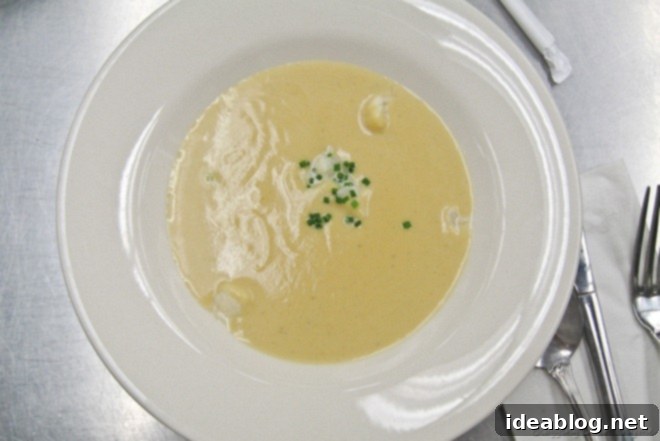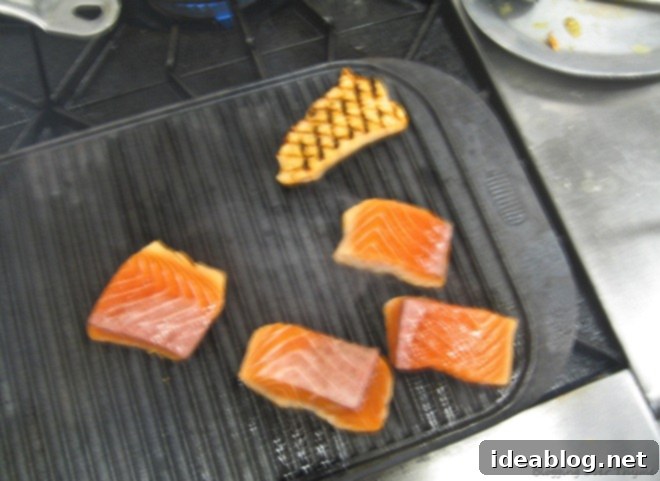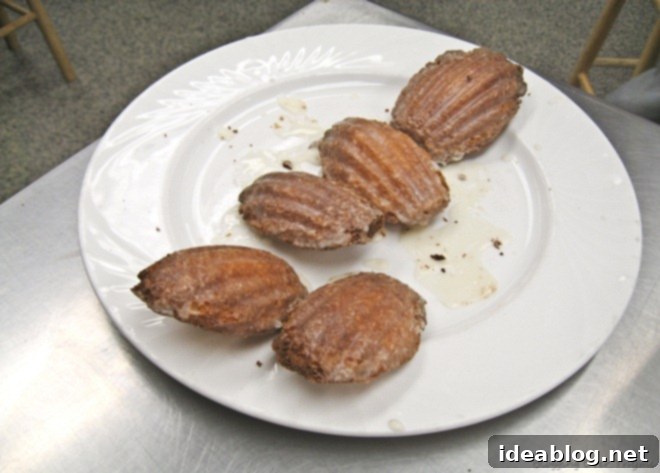Mastering Classic French Cuisine: A Culinary Class Journey Through Sauces, Soups & Pastries
The immersive journey through the intricate world of classic French cuisine continues to be an exhilarating, albeit demanding, experience. Each day spent in the culinary academy brings forth new techniques, challenging recipes, and a profoundly deeper understanding of the foundational principles that define gourmet cooking. While the kitchen can get quite warm during our intensive sessions, the unwavering passion for perfecting these intricate dishes remains the driving force behind every lesson. Today, I am thrilled to share a detailed recap of our latest culinary class, where we delved into a delightful and complex array of dishes, ranging from a comforting and refined soup to a sophisticated main course and an iconic French dessert. All the while, we meticulously honed our professional kitchen skills and expanded our repertoire. My apologies for the limited or slightly blurry photographs; the intense focus required during the cooking process often leaves little opportunity for perfect shots, but I promise vivid descriptions to thoroughly compensate!
A Rich Beginning: The Elegant Simplicity of Cauliflower Soup

Our recent culinary session commenced with an exploration into the realm of refined starters: a beautifully crafted Cauliflower Soup. This dish, despite its seemingly straightforward nature, perfectly exemplified how a judicious selection of quality ingredients combined with precise technique can yield remarkably profound flavors. The soup was carefully built upon a delicate base of gently sautéed leeks, which provided a subtle and aromatic foundation. Naturally, the star ingredient was fresh cauliflower, contributing its characteristic earthy sweetness and creamy texture when cooked. To achieve a perfectly smooth consistency and add a natural, subtle body, we incorporated a small amount of potato scraps – a clever and economical trick often employed in professional kitchens to naturally thicken soups without relying solely on heavy cream or flour. A mere pinch of curry powder was introduced, not to dominate the flavor profile with spiciness, but rather to lend a warm, intriguing undertone that subtly elevated the cauliflower’s inherent taste. The liquid base was a meticulously prepared chicken stock, simmered to perfection to extract maximum depth of flavor. The soup was then finished with a small, precise dose of heavy cream, which added a luxurious mouthfeel and beautifully unified all the intricate flavors. The resulting soup was incredibly flavorful, deeply comforting, and a true testament to the idea that simplicity, when executed flawlessly with attention to detail, can be truly exquisite. Despite the soaring temperatures in the kitchen, this rich and warming soup was a delightful creation, proving that the enjoyment of good food transcends external conditions and offers genuine culinary satisfaction.
The Main Event: Perfectly Grilled Salmon with Classic French Accompaniments
For our eagerly anticipated main course, our focus was squarely on precision cooking and the art of classic French pairings: expertly prepared grilled salmon. Achieving the perfect grill on a delicate piece of fish like salmon is unequivocally an art form in itself, demanding careful temperature control, precise timing, and keen attention to detail to ensure a crispy, beautifully seared skin and a moist, flaky interior. The primary goal was to create those visually appealing, professional grill marks that signify mastery, all without the unforgivable sin of overcooking the fish. This impeccably cooked salmon was gracefully served alongside a vibrant green plain broccoli, offering a fresh, slightly bitter counterpoint to the richness of the fish, and the classic French side dish, Pommes Rissolees. Please forgive the slightly blurry nature of the photograph below, but it nonetheless offers a tantalizing glimpse of the impressive and meticulously achieved grill marks on our salmon fillets, a source of quiet pride in the kitchen.

Unveiling Sauce Choron: A Masterclass in Hollandaise Derivatives and French Sauce Making
One of the undoubted highlights of the main course, and indeed a significant learning curve in our entire class, was the intricate preparation of Sauce Choron. This elegant and complex sauce is a cornerstone of classic French cuisine, particularly renowned for its perfect and harmonious pairing with expertly grilled salmon. Sauce Choron represents a fascinating and advanced exploration into the world of French mother sauces and their intricate derivatives, specifically stemming from the esteemed and notoriously temperamental Hollandaise sauce. Our comprehensive culinary curriculum has already introduced us to another Hollandaise derivative, Béarnaise sauce, which we previously mastered and served with a succulent roast beef. This continuous layering of knowledge, where each new sauce or technique builds upon previously learned fundamentals, truly reinforces the interconnectedness and logical progression inherent in the art of French culinary arts.
To fully appreciate the nuanced beauty and complexity of Sauce Choron, one must first possess a solid understanding of its illustrious lineage. Hollandaise sauce itself stands as one of the five venerable French mother sauces, a rich and delicate emulsion crafted from egg yolks, clarified butter, and either lemon juice or white wine vinegar. Its creation demands immense precision, constant vigilant whisking, and meticulous temperature management to skillfully prevent the egg yolks from scrambling or the delicate emulsion from breaking. Béarnaise sauce, the immediate predecessor to Choron, builds upon the Hollandaise foundation by incorporating a distinctive reduction of finely minced shallots, robust red wine vinegar, freshly crushed black peppercorns, and either dried or fresh tarragon. This aromatic reduction is what imparts Béarnaise with its signature herbaceous, slightly piquant, and undeniably complex flavor profile, making it an archetypal accompaniment for steaks, roasts, and grilled meats.
Sauce Choron masterfully takes this derivative concept a significant step further. It begins with the established foundation of a Béarnaise sauce – utilizing the same meticulously prepared tarragon reduction expertly infused into a Hollandaise base. However, what unequivocally sets Choron apart, transforming it into its own unique entity, is the innovative addition of tomato concasse. This specific ingredient introduces a fresh, subtle sweetness, a delicate fruity acidity, and a beautiful, inviting pinkish hue to the sauce, making it even more versatile, visually appealing, and texturally interesting. We had previously encountered and practiced the preparation of tomato concasse in another foundational lesson, where it beautifully complemented a plate of scrambled eggs. For those who may be unfamiliar, tomato concasse is essentially a precise preparation of fresh tomatoes that have been meticulously peeled (often blanched for ease), carefully seeded to remove excess moisture and bitterness, and then finely diced. This preparation is then often gently cooked or simply served raw, importantly kept free of excess liquid and strong aromatics like garlic or onion, allowing the pure, unadulterated fresh tomato flavor to truly shine. Its artful inclusion in Sauce Choron adds a delightful textural element and a gentle, bright acidity that perfectly cuts through and complements the inherent richness of the grilled salmon, creating a harmonious and balanced culinary experience. The skill involved in creating these sauces truly highlights the precision and depth required in professional French cooking.
The Art of Pommes Rissolees: A Classic and Elegant Potato Accompaniment
Harmoniously complementing our meticulously grilled salmon were the Pommes Rissolees, another exemplary side dish drawn directly from the classical French repertoire that magnificently showcases both precision in technique and sophisticated flavor. These are far from being just any ordinary roasted potatoes; their preparation begins with “tourneed” potatoes. The ‘tournée’ technique is a fundamental and revered skill rigorously taught in professional culinary schools, where potatoes are meticulously carved by hand into uniform, elegant, barrel-like or olive shapes using a specialized tourné knife. This painstaking process not only results in an exceptionally elegant and consistent presentation but, crucially, also ensures remarkably even cooking throughout each piece. After being expertly tourneed, these perfectly shaped potatoes are brought just to a gentle boil, ensuring they are slightly softened without becoming mushy, then thoroughly drained and meticulously dried to remove all surface moisture. This par-boiling step is essential as it initiates the cooking process and creates a more receptive surface for browning. The final, and arguably most crucial, step involves sautéing these carefully prepped potatoes in a generous amount of clarified butter until they achieve a magnificent, enticing golden-brown hue and develop a wonderfully crispy exterior, all while remaining wonderfully tender and fluffy on the inside. Clarified butter is unequivocally preferred in this application because its significantly higher smoke point allows for longer cooking and more intense browning without burning, and its pure butterfat imparts a cleaner, richer, and more authentic butter flavor compared to whole butter, which contains milk solids that burn easily. This seemingly simple side dish, while minimalist in its components, is profoundly complex in its execution and adds a beautiful, textural contrast and a rich, satisfying flavor profile to the main course, elevating the entire dining experience.
A Sweet and Delicate Conclusion: Lemon Glazed Madeleines
No truly authentic French meal, particularly one crafted with such care and precision, could ever be considered complete without a delightful and memorable dessert. Our culinary class concluded on a high note with the creation of exquisite Madeleines, delicate shell-shaped sponge cakes generously coated in a bright, zesty lemon glaze. These small, iconic pastries are deeply ingrained in French culture and literary history, famously immortalized by Marcel Proust. As you can clearly discern from the photograph below, these delicate treats were so incredibly popular and irresistible that several had already been eagerly savored from the plate even before I had a chance to capture a perfect, untouched shot! The process of making Madeleines, while seemingly deceptively simple, yields a cake with a unique and highly desirable texture – characteristically crisp edges, a wonderfully soft and tender interior, and, most notably, that signature “hump” on top.
The culinary secret to achieving this distinctive hump and a perfectly defined shell shape lies in a crucial step: chilling the Madeleine dough thoroughly for a significant period before baking. The thermal shock created by placing cold dough into a hot oven causes the edges of the batter to set quickly, while the center continues to expand dramatically due to the leavening agent and steam, forcing it upwards to create that beloved, unmistakable bump. Our recipe, a classic and enduring foundation, is refreshingly easy to commit to memory: precisely 4 ounces of granulated sugar, 4 ounces of unsalted butter, 2 large eggs, 4 ounces of all-purpose flour, and 2 teaspoons of baking powder. To this perfectly balanced base, we added a touch of vibrant, aromatic lemon zest for an invigorating brightness and a hint of pure vanilla extract for warmth and an added layer of flavor depth. Once baked to a beautiful, inviting golden brown, each individual Madeleine was generously coated in a simple yet incredibly invigorating lemon glaze. This glaze, made from confectioners’ sugar and fresh lemon juice, added a tangy sweetness and a glossy finish that perfectly complemented the rich, buttery flavor of the cake, creating a harmonious taste sensation. The entire process, from the initial careful mixing of ingredients to the precise baking and elegant glazing, was a valuable lesson in patience, precision, and the rewarding art of French pastry, resulting in a batch of Madeleines that were truly irresistible and a testament to refined baking skills.
Anticipating Consommé: The Pinnacle of Broth Clarification and French Culinary Artistry
Immediately after serving our delicious and meticulously prepared lunch, we promptly returned to the bustling, energetic kitchen, shifting our collective focus to crucial preparations for future lessons. The entire afternoon was dedicated not only to the continuous and absolutely essential task of trimming more chickens for fresh stock – a fundamental and ongoing process in any high-caliber professional kitchen – but also to initiating the elaborate and highly specialized process of making consommé. Consommé, which we are eagerly anticipating to proudly serve in our very next class, is far more than just a simple, flavorful broth; it is widely regarded as the absolute epitome of clarified liquid, a highly fortified, intensely flavorful essence that represents one of the ultimate and most challenging tests of a chef’s skill and patience. The intricate creation of consommé involves a very specific, complex, and time-consuming multi-stage process known as clarification, where a meticulously prepared “raft” is formed. This raft typically consists of lean ground meat (often beef or chicken), finely chopped mirepoix (carrots, celery, onions), aromatic herbs, and, crucially, whipped egg whites. This mixture is then carefully added to a chilled, flavorful broth and very slowly brought to a simmer. As the mixture heats, the egg whites and other solids coagulate and rise to the surface, forming a dense, cohesive “raft.” This raft meticulously traps impurities and fat particles as it slowly cooks, leaving behind a perfectly clear, shimmering, amber-hued, and deeply flavored liquid. The immense patience, acute observation, and unwavering precision required for this sophisticated technique are immense, and I am genuinely eager to share much more about this fascinating culinary art form, including its scientific principles and historical significance, in tomorrow’s detailed blog post. It truly is a remarkable demonstration of transforming humble ingredients into something exquisitely extraordinary through dedication, scientific understanding, and sheer culinary artistry.
Looking Ahead: The Excitement of an Externship and Continuous Culinary Growth
Beyond the daily rigors and intense practical demands of the professional kitchen, this week also brings with it significant academic and career-defining milestones in my ongoing culinary education. Tomorrow, I have a third academic paper due, which will require a demanding but necessary shift from hands-on practical cooking to in-depth theoretical research, critical analysis, and academic writing. Even more importantly, I am scheduled for my very first pivotal meeting to discuss my upcoming externship during Phase III of the culinary program. This externship represents an absolutely crucial step in my professional development and the culmination of my training, offering invaluable real-world experience in a dynamic, high-pressure working kitchen environment. It is a unique and exciting opportunity to apply all the meticulous techniques, foundational principles, and advanced knowledge gained throughout my classes to a fast-paced professional setting, to learn directly from seasoned, experienced chefs, and to further refine my skills under true industry conditions. The prospect of this externship is undeniably both incredibly exciting and, I must admit, a little daunting, marking a significant and transformative transition from an eager student to an aspiring professional chef ready to embark on a fulfilling culinary career.
Every single day spent in culinary school profoundly reinforces the enduring idea that cooking is not merely a task, but a lifelong journey of continuous learning, relentless precise execution, and an unwavering, fervent passion for flavor and culinary artistry. From mastering the foundational mother sauces and their intricate derivatives to baking delicate, iconic pastries and crafting incredibly complex, clarified broths, each lesson thoughtfully builds upon the last, deepening our understanding, refining our craft, and expanding our culinary horizons. I eagerly look forward to sharing many more insights, invaluable experiences, and delicious discoveries from this incredible and rewarding culinary adventure with you all in the future.
Until next time, keep cooking with passion, experimenting with flavor, and bon appétit!
